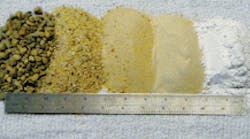Authored by: Edited by Lindsey Frick Key points: Resources: |
The dark days of energy-hogging, poorly toleranced cast parts are over. A new casting method dampens vibration and uses less energy during production. The technology is called cast-totolerance (CTT) synthetic-quartz-composite casting and the magic lies in the mixture.
CTT synthetic-quartz composite is a precisely formulated mixture of high purity quartz aggregates, liquid-polymer resin, and various air release and wetting agents. Depending on the degree of tolerance required for the finished casting, the size of quartz particles in the mixture range from a fine powder to 10-mm grains. Castings can be made for specific applications by blending in different types of liquid-polymer resins with the quartz aggregates.
When liquid resin Bisphenol-F epoxy is used in the mixture, it produces a casting that resists chemicals, making it a good alternative to stainless steel. CTT castings do not rust or deteriorate from exposure to aggressive coolants.
CTT castings commonly go into vibration-dampening applications. To make castings that dampen vibration, liquid resins such as Bisphenol-A epoxy, Methyl methacrylate, or rigid urethane are used in the mixture. Machines that use this type of casting include those for inspection, prepress plate setters, and pick-and-place equipment. Reduced vibration lets these machines operate faster and with greater accuracy. For cutting machinery, these castings extend cutting-tool life by one-third.
Heat transfer and electrical conductivity are two properties to keep in mind when using CTT castings. The CTT material does not transfer heat well or conduct electricity thoroughly. This is a benefit when casting machine tools because the machine base will not easily move when heat builds during machining. The application of a conductive gel coat on the casting will make it conductive, as will placing wiring into the mold prior to casting.
Tolerance in the tooling
Tooling for the CTT mixture must be machined to closer tolerances than the desired finished tolerances on the casting. Steels used to make the tooling must have good wear qualities, but the tooling does not need heat treatment. Proper tool design and construction is critical to holding precise tolerances. And as any designer knows, tolerance costs money.
Luckily, the CTT technology offers a poor-man’s tooling option. When a high-precision top surface of a casting is required (bottom of the mold), only the mold base is machined. Then low-cost sheet steel can be used to create the sides and cores. It is even possible to use wood sides with a precision steel-base mold.
Typical mold tolerances are 0.0005-in./ft flatness, 0.001-in. total indicator reading (TIR) for surfaces, and 0.0001-in. diameters. The finished part dimensions often exactly match the mold, but not consistently enough to say every casting will be to tolerance. For routine production, assume the finished part tolerances will be one-half of the mold tolerances. CTT castings can, therefore, be cast to 0.001-in./ft flatness, 0.002-in. TIR surfaces, and 0.0002-in. diameters. Closer tolerances are possible, but at some point, the cost of the tooling exceeds the value.
One of the biggest issues to keep in mind with high-precision casting is inspection. When trying to qualify close-tolerance surfaces, the inspection technique must be agreed upon prior to production. Although 0.0002-in. flatness should be the same regardless of the inspection technique, it often is not. The technique used to qualify dimensions will affect the readings so it is important to find an inspection technique that both the vendor and customer have available.
Energy and cost saving
Finished CTT castings typically consume 85% less energy during production than similar cast-iron parts. One reason is that CTT almost eliminates all secondary operations. Once the CTT tooling has been produced and qualified, the casting process consists of assembling the tooling and installing inserts that replace the need for machining. For example, steel or stainless-steel threaded inserts are cast-in to create standard tapped holes. Other types of inserts like foam can be cast-in as the structural core of the casting, which reduces weight and cost. CTT castings can also be cast in color. This means secondary operations like painting or plating can be eliminated.
Unlike cast iron, CTT mixture can be blended and poured into the mold at room temperature. Vibration and/or mechanical pressure then compacts the mixture to reduce air voids and to fill every recess in the tooling. Some castings are consolidated by applying a vacuum depending on the formulation of the mixture, size of the casting, and its cure time. Overall, the method of casting a synthetic-quartz-composite mixture produces finished parts that need little to no inspection as the feature placement, color, and tolerance stay consistent from part to part.
6,000 years later Casting: A 6,000-year-old process where a material in liquid form is poured into a mold to produce a harder part called a casting. Cast-to-tolerance (CTT) synthetic-quartz-composite casting: A technology involving an exothermic pour material made of quartz aggregates and liquid resin. The mixture is poured into the mold at room temperature and compresses to match tolerances with the assistance of vibration, mechanical pressure, or a vacuum. |
